To demonstrate the power of hydraulics, some of my students and I built a hovercraft out of plywood and a wet/dry vacuum cleaner.
We more or less followed the instructions on a web page entitled Hovercraft Science Fair Project: Vacuum Cleaner Powered. The base was a circle that we cut from a 4′ × 4′ sheet of ½” plywood, using a jig saw. We cut a 1½” hole in the plywood to accommodate the hose from the vacuum.
We put a sheet of thick plastic (I don’t know the thickness, but it’s probably at least 4–5 mil) under it, screwed a plastic lid from a coffee can in the center to hold it, and cut six 2″ holes with a razor blade. We also put a piece of duct tape on both sides of the plastic where the hose attaches to give it some extra strength. (Otherwise, the hose can cut the plastic when it’s being inserted.)
We stapled the plastic with a staple gun, spacing the staples about 2″ apart, and duct taped the edges of the plastic to ensure a good seal. We protected the edges with a couple of discarded bicycle tires, which we got from a local bike shop. (It was necessary to cut the metal bead off the tire. This was difficult, but made it a lot easier to fit the tires around the edge.) The bike tires were stapled to the top of the plywood.
We then inserted the vacuum hose into the outlet (blower) port, inserted the other end into the hovercraft base, and put a chair in the middle:
The vacuum is an old Bissell model 6020-1 wet/dry vacuum, which has a 6 amp motor. It worked well, and was capable of lifting at least three students. (The limitation seemed to be how many of them could fit on the plywood.)
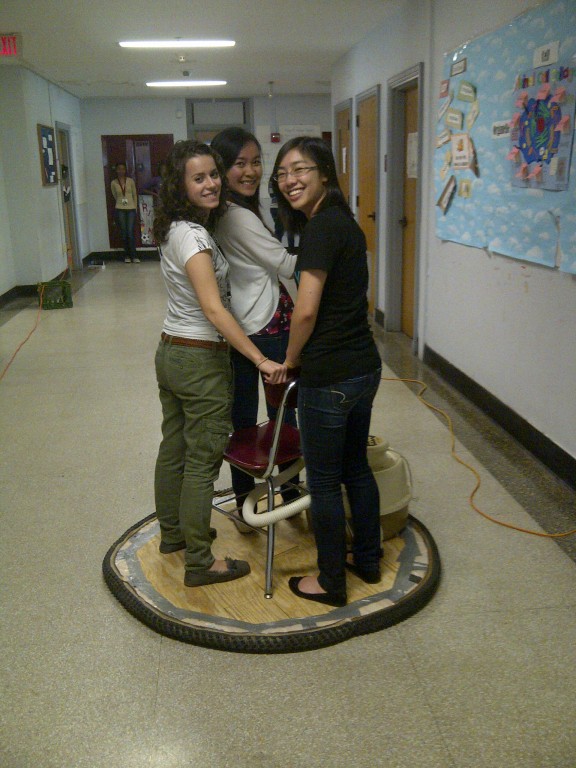
Three students enjoying the ride.
A rough calculation of the hydraulics (based on the vacuum cleaner being able to lift water to a height of at least 1.5 m) suggests that if there were no losses, it could theoretically lift about two tons. We were able to make it hover with a couple of different groups of three students, though we had a little trouble keeping the weight balanced so the skirt remained full of air. This suggests that a weight of about 500 pounds seemed to be approaching the useful limit.
Lessons Learned
If you want to build one of these yourself, here’s what we learned by doing it:
- If the hovercraft fails to hover, it’s almost certainly because air is leaking out of the skirt. This can be because:
- The plastic isn’t tight enough. It needs to be stretched fairly tight. This was easy to do by setting the plywood on top of the plastic (after attaching the plastic disc and cutting the holes) and then wrapping the plastic around the edge of the plywood and stapling it down.
- The plastic ripped. This is most likely to happen at the edge, and it happened to ours before we put the bike tire on to protect it.
- The bike tires are a win. Besides protecting the edge, they are thick enough to maintain a little space between the plywood and the floor. This gives the skirt room to keep inflated all the way around, which keeps the hovercraft hovering. Conveniently, two scrap 27″ bike tires are exactly big enough to go around a 4′ diameter circle. A local bike shop had plenty of damaged & unusable bike tires that they were happy to give me.
- You want a tight fit where the vacuum cleaner hose goes into the plywood. Gaffer’s tape (rather than duct tape) is a win if you need to add a little bulk to the diameter of the vacuum cleaner hose.
- Judging from the number of times I managed to knock the vacuum cleaner (and occasionally the chair) off the hovercraft by bumping into it with my foot as I was towing my students around, a fishtank full of eels would seem like an accident waiting to happen. (I guess I’ll have to find another opportunity to use that Hungarian phrasebook.)

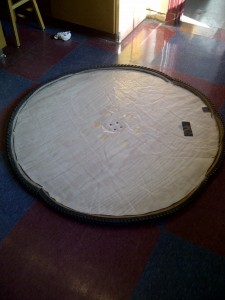
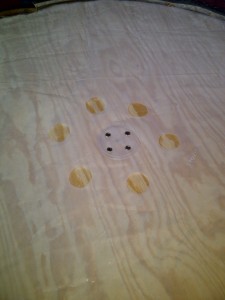
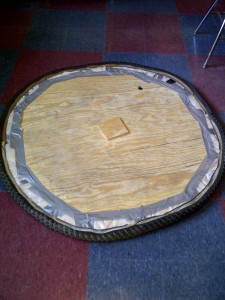
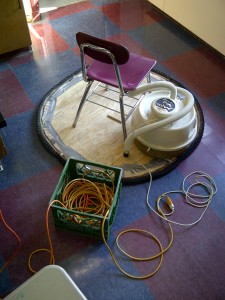
Monty Python Fluxx has a card “My hovercraft is full of eels”.
This is SO cool, as well as an excellent proof of concept. I will forward this to a couple of ‘geek friends’ (including Bob and my son).
After seeing this you’ve encouraged me to take up this project as part of my school STEM (science technology engineering and maths) class. Do you have any other pictures of hovercraft? Any extra info you could give me?
Also, how did you calculate the hydraulics of the vaccum? 2t sounds like a huge amount!
The link at the beginning of the post was the instructions I used, and they worked well. If you Google “vacuum cleaner hovercraft” there seem to be quite a few pictures on the Internet.
I put the extra info that I learned in the “lessons learned” section of the post.
For the theoretical calculation, I used the manufacturer’s spec for how high it could lift a column of water (1.5 m). This gives a hydrostatic pressure of P = ρgh = (1000)(10)(1.5) = 15 000 Pa coming out of the hose.
The plywood is a 4-foot diameter circle, so its area is about 1.2 m2. If P = F/A, then 15 000 = F/1.2. This gives a force of 18 000 N, which is about 1800 kg.
As I mentioned in the post, the practical limit is much less, if nothing else because of the practical difficulty of keeping the board level and the skirt full of air. Someday I’d like to try it with a cordless shop vac, because managing the cord is a bit of a nuisance.